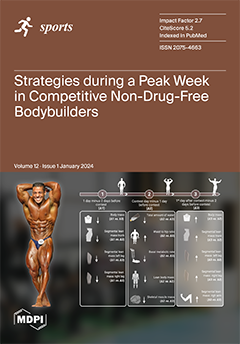This study aimed (1) to assess the validity of a modified method (M
mod) based on heart rate (HR)—oxygen uptake (VO
2) regression functions to calculate total energy costs (W
total) and aerobic (W
aer) and anaerobic alactic energy
[...] Read more.
This study aimed (1) to assess the validity of a modified method (M
mod) based on heart rate (HR)—oxygen uptake (VO
2) regression functions to calculate total energy costs (W
total) and aerobic (W
aer) and anaerobic alactic energy contribution (W
pcr) and (2) to analyse the physiological and energetic demands of high-level pommel horse routines (PH routines). The M
mod was developed because VO
2 measurements are limited during high-level PH routines. Answering Part 1, nine male artistic gymnasts performed a PH routine where energy costs were calculated from VO
2 measurements and then compared with energy costs determined from the HR- VO
2 regressions of M
mod’s two additional tests. Using the concordance correlation coefficient (CCC) and Deming regression, W
aer (CCC = 0.955), W
pcr (CCC = 0.999), and W
total (CCC = 0.990) show substantial to almost perfect validity without constant or proportional bias. Data from eight further gymnasts performing a high-level PH routine and a graded exercise test (GXT), as well as four data sets from Part 1, were used to determine physiological and energetic demands using M
mod. VO
2 and HR during PH routines reached 86.1% and 90.4% of the maximal values during GXT. W
pcr was 47.0%, anaerobic lactic energy contribution (W
blc) was 29.7%, and W
aer was 23.3% of W
total required during PH routines. Summarising the energetic demands of high-level PH routines, they are mainly anaerobic, where W
pcr provides the largest energy share. W
aer provides a substantial part of W
total and should therefore also be specifically trained.
Full article






